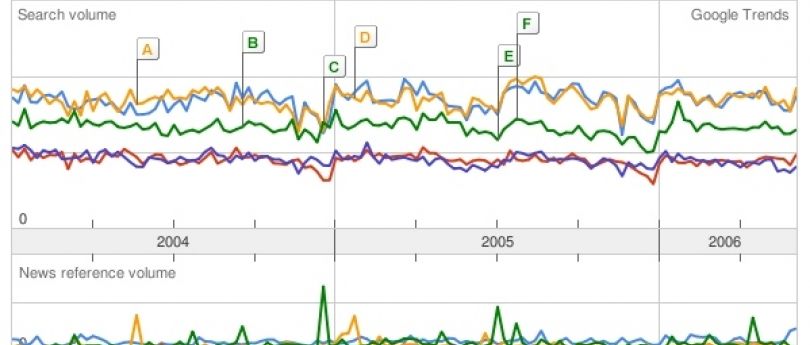Kennis /
Archive 2020: Archiving Web Dynamics

Google Trends en de dynamiek van het web
— Archives have the important task to save cultural heritage from disappearing into the past. The field of Web archiving is faced with documents that are characterized by their dynamic nature, leading to difficulties in the archiving process.
Archiving Web dynamics
Web
archives are faced with an unstable object of preservation. This
instability is mostly discussed in terms of 'ephemerality' of Web
objects. Web objects that exist in the present may not be there in
months, days, minutes even. One approach to deal with the medium's
ephemerality is the editorial approach to Web archiving. It is based on
capturing a predefined selection of URLs over time. The medium-specific
approach proposed here focuses on the prominence of Websites in their
digital environment, including relations between Websites and their
place in a larger entity. Think for example of the rise and fall of
sources in the top 20 of search engine result listings for a particular
query (http://issuedramaturg.issuecrawler.net/issuedramaturg_story/911truth.org.html), the absence or presence of hyperlink networks among actors (http://govcom.org/gco_projects/pisp/GC0_Maps_set_ps_8.pdf) or the Web effects of Internet censorship (http://govcom.org/maps/censorship/gco_tab_china.pdf, http://govcom.org/maps/censorship/gco_tab-balochi_1_final.pdf).
The aim of the discussion is to explore ways to start archiving the
dynamics of the Web by focusing on digital objects that create relations
between and contexts of the 'born digital' records. Including the
hyperlink, search engine returns and tags. These collection methods
could be informed by looking at how devices that are common on the Web
deal with these objects, such as search engines, platforms and
recommender systems.
How and why do current Web archives look as they do? This question is discussed to start thinking about a contribution to Web archiving. Web archives are shaped by the period and spirit from which they emerge. When archives think of time, they usually refer to the creation date of documents. Here, the creation date of the Web archives is discussed. Two Web archiving projects are looked at in more detail.
The first project, which strives to save the entire Web, the Internet Archive, is compared to the Web archive of the Royal Library of the Netherlands (the KB) that currently comprises 400 Websites. The Internet Archive started archiving in the nineties, which was dominated by the notion of cyberspace. Both the scope of the collection (e.g. the entire Web) as well as the navigating the archive through the Wayback Machine (e.g. URL search and subsequently browsing from page to page) are exemplary of cyber spatial thinking. At the beginning of this century, the notion of cyberspace was confronted with the 'national turn,' where the Web manifests itself nationally. Think for example of the country versions of Google (e.g. Google.nl), national social networking services (e.g. Hyves) and enforcement of copyright law on national level (e.g. "this video is not available in your country"). Also in Web archiving a number of projects have emerged which archive with a national focus. The KB is an example of this 'national turn' in the Web archiving.
The two archiving projects also
differ in their approach to the collection object. The Internet Archive
delegates the selection of Websites to be included in the archive to
users, while the KB approaches collection objects from an editorial
perspective. The former uses traffic data to identify sources for
collection (provided by Alexa.com), the latter has a team of experts
selecting relevant Websites in their field of expertise. The general
library policy and research programs shape the collection policy and
research focus of the Web archive.
The questions explored here
are, what would the national Web archive look like when the focus is on
capturing hyperlinks, search engine results, and other digital objects?
What aspects besides the digital document are relevant to save and why?
Can we learn from how born digital devices (e.g. search engines,
platforms and recommendation systems) make use of the objects, and if
so, how can such uses be repurposed for Web archiving?
Biography Esther Weltevrede
Esther
Weltevrede is a PhD candidate and lecturer at the New Media department
at the University of Amsterdam. She is researcher at the Research and
PhD Program Digital Methods Initiative (DMI), which aims to develop novel methods and tools for studying the Web. Since 2007 she is a member of govcom.org, a foundation dedicated to development of political tools on the Web.
Her
PhD research is about national Webs. As part of the Digital Methods
Initiative, this particular study aims to develop methods and tools with
a locative-technical focus. The aim of this study is two-folded.
Firstly, to locate and demarcate national Web spaces utilizing various
locative-technical indicators of the Web. Secondly, to diagnose the
condition of a country from a Web perspective by analyzing social
communication within the demarcated space.
Archiving Web Dynamics is a case study that is presented at Archive 2020.
Share
Gerelateerde thema's
Interessante ontwikkelingen die organisatiebreed worden behandeld.
